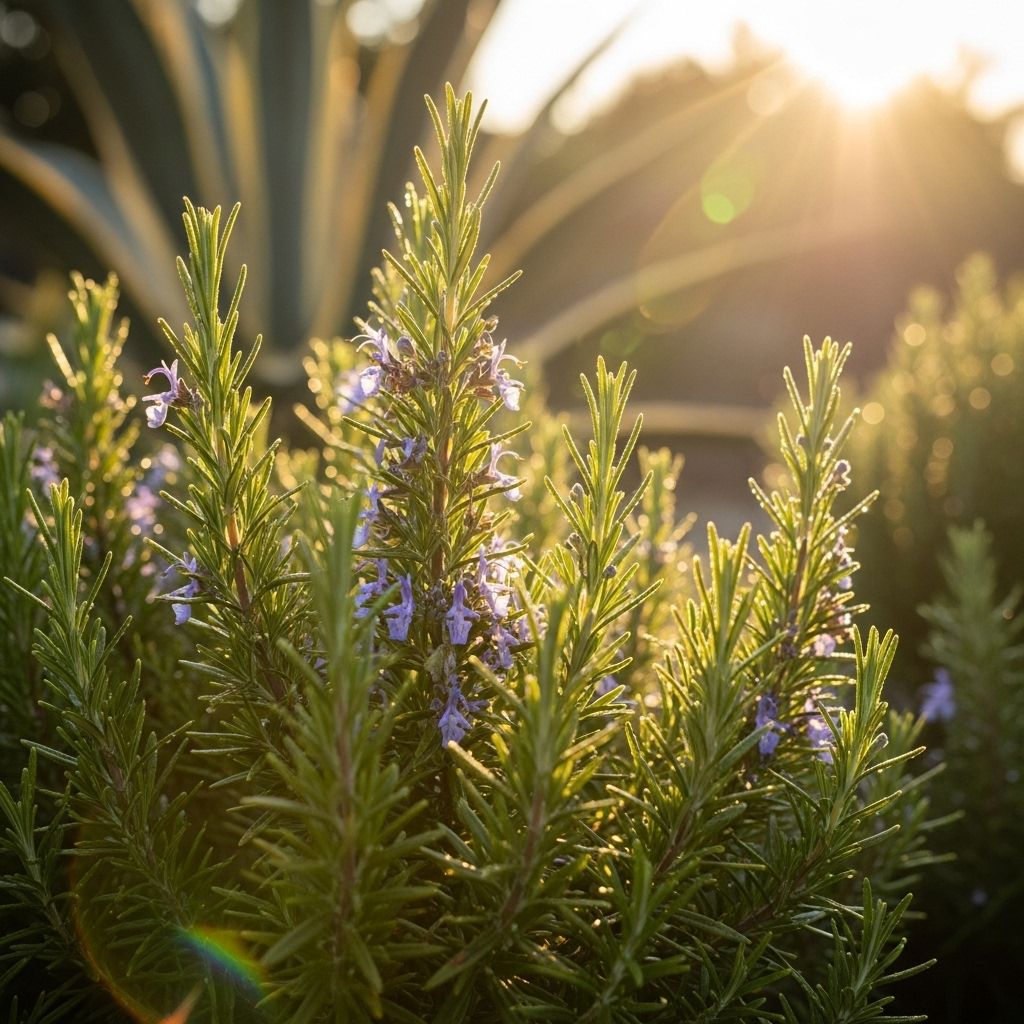Rosemary Sunlight Requirements: How Much Sun Does Rosemary Need?
Intense herbal aromas bloom when plants soak up just the right amount of warmth and air.

Image: HearthJunction Design Team
Rosemary (Rosmarinus officinalis) is a classic Mediterranean herb cherished for its earthy aroma, piney needle-like leaves, and culinary versatility. Known for being low-maintenance and drought-tolerant, rosemary rewards gardeners with robust growth and fragrant foliage—if you meet its sunlight needs. This comprehensive guide explores how much sun rosemary truly needs, why sunlight is essential for its growth and fragrance, and how to ensure your rosemary flourishes whether outdoors or indoors.
Does Rosemary Need Full Sun, Partial Shade, or Full Shade?
Rosemary thrives on sunlight and warmth. Native to the sun-baked slopes of the Mediterranean, this herb loves locations that bask in direct sunlight for at least six hours daily. Insufficient sunlight can lead to sparse, weak growth and diminished flavor and fragrance. Let’s break down the precise light needs for healthy rosemary plants:
- Full Sun: Rosemary prefers a spot receiving at least 6 to 8 hours of direct sunlight every day. This is the gold standard for vibrant growth and aromatic foliage.
“Rosemary is a sun-loving Mediterranean native that thrives in rocky gardens… It cannot grow to its full potential without direct sunshine.” - Partial Shade: Only advisable in very hot climates (when summer temperatures stay above 95°F/35°C), where some gentle afternoon shade can provide relief from scorching sun. Otherwise, partial shade leads to reduced essential oil production and leggy growth.
- Full Shade: Not recommended. Rosemary will struggle, become weak, and is unlikely to survive long-term in full shade conditions.
Whether you grow rosemary outdoors in the ground, in raised beds, or indoors in containers, sun exposure is the most critical factor for success.
The Science: Sunlight and Rosemary’s Aroma
The signature earthy, sage-like scent of rosemary comes from its volatile essential oils (terpenes), produced in structures called trichomes on the leaves. Light exposure is directly linked to essential oil formation. More light increases the density and potency of trichomes, resulting in a stronger aroma.
- More sun = More trichomes = More powerful fragrance.
- Essential oils also help rosemary defend against UV damage and herbivorous pests.
- In extremely hot weather (consistently above 95°F), rosemary may produce less oil, so scent can diminish slightly.
This explains why rosemary, when grown in the full sun of its Mediterranean homeland, develops such robust and aromatic foliage.
How Much Sun Does Rosemary Need?
For rosemary to reach its full potential, aim for the following light conditions:
- Minimum: 6 hours of direct sunlight per day
- Optimal: 8-10 hours of sunlight, especially during the growing season
- Winter: Rosemary tolerates some cloudiness or brief periods of reduced sunlight but should not be left in dark, shaded environments for extended periods.
Rosemary shares similar light preferences with other Mediterranean herbs like lavender, sage, thyme, and oregano. Grouping these together in a sunny spot creates an ideal herb garden with minimal nutrient competition and maximum fragrance.
Table: Rosemary Sunlight Comparison
| Sunlight Level | Growth | Fragrance | Recommended? |
|---|---|---|---|
| Full Sun (6-8+ hrs) | Vigorous, compact, lush | Strong, piney aroma | Yes |
| Partial Shade (3-6 hrs) | Slower, leggy, sparse | Weaker scent | Only in extremely hot climates |
| Full Shade (<3 hrs) | Poor, weak, likely to die | Very faint or absent | No |
Where and How to Position Rosemary for Maximum Sunlight
To ensure your rosemary receives proper sunlight, follow these guidelines when selecting a location and planting:
- Outdoor Placement: Choose a garden area with direct, unfiltered sunlight—free from shadows cast by trees, fences, or buildings. Plant rosemary on the south or west side of your home for optimal exposure.
- Container Gardening: Locate potted rosemary in a sunny spot on your patio, balcony, or porch. Move containers to follow the sun if needed.
- Indoors: Place pots in front of a south-facing window where they receive the maximum amount of direct sunlight. Supplemental grow lights can be used during winter or in less sunny homes.
- Raised Beds: Build beds in the sunniest section of your yard. Avoid areas where large shrubs or structures may shade the beds during the day.
Sunlight and Soil: The Complete Mediterranean Formula
Sunlight alone isn’t enough—for true rosemary success, you must also provide well-drained soil that mimics the rocky, sandy habitats of the Mediterranean. Here’s the ideal setup:
- Soil Type: Sandy, gravelly, or rocky soils with quick drainage. Avoid heavy clay or soggy, waterlogged spots.
- Garden Bed: Raised beds or rock gardens are ideal for drainage and sun exposure.
- Companion Herbs: Group rosemary with lavender, thyme, and sage for a low-maintenance, fragrant Mediterranean garden.
Rosemary also does well in containers, provided pots are unglazed clay or have excellent drainage holes—and are placed in the sun.
Growing Rosemary Indoors: Maximizing Light in Your Home
While rosemary thrives best outdoors, you can grow this herb inside with the right light conditions. Follow these tips for indoor success:
- South-Facing Windows: Place rosemary directly in front of the window for at least 6 hours of sunlight daily.
- Supplemental Lighting: Use full-spectrum grow lights if your space lacks natural sunlight. Keep lights on for 12-16 hours per day to compensate.
- Rotate Pots: Turn your rosemary every week to ensure even sun exposure and prevent lopsided growth.
Indoor rosemary may grow slower and be less aromatic compared to outdoor plants, so consider moving pots outside during summer for a sun boost.
Sunlight in Extreme Climates: Too Much or Too Little?
Too Much Heat: Although rosemary is heat tolerant, temperatures above 95°F (35°C) for extended periods can stress the plant. In these cases:
- Provide some gentle afternoon shade in the hottest parts of the day.
- Ensure the soil remains slightly moist but never soggy.
- Avoid heavy mulching as it may retain too much heat around the roots.
Too Little Sun: In shady yards or northern climates (or during long, cloudy winters), consider:
- Strategically pruning back overhanging trees or shrubs.
- Growing rosemary in containers that can be moved to chase available sunlight.
- Utilizing grow lights indoors to simulate longer, brighter days.
Pro Tips for Sun-Soaked, Fragrant Rosemary
- Prune rosemary lightly every year to keep it bushy, encourage air flow, and expose more leaves to the sun.
- Harvest sprigs in the morning, when essential oil content is highest thanks to overnight cooling and morning sunlight.
- Don’t over-fertilize; rich, nutrient-heavy soil can lead to weak, floppy stems instead of compact, aromatic foliage.
- Water deeply, but infrequently—let the soil almost dry between waterings, mimicking Mediterranean drought cycles.
- Monitor your local microclimate; adjust placement if your rosemary struggles to thrive or exhibits reduced scent.
Common Questions About Rosemary and Sunlight
Frequently Asked Questions (FAQs)
Q: Can rosemary survive in partial shade?
A: Rosemary can tolerate partial shade in very hot southern climates, but for the best growth and aroma, it needs at least 6 hours of direct sunlight each day. Shade reduces the plant’s fragrance, vigor, and essential oil production.
Q: What happens if rosemary doesn’t get enough sunlight?
A: Insufficient sunlight results in leggy, sparse growth, reduced fragrance, and weaker flavor. Plants in shade are susceptible to disease and rarely thrive long-term.
Q: Can I grow rosemary indoors without a sunny window?
A: Yes, but you’ll need a strong grow light placed close to the plant for 12-16 hours per day. Without enough light, indoor rosemary won’t be as aromatic or robust as outdoor-grown plants.
Q: Should rosemary be shaded in extremely hot climates?
A: If summer temperatures regularly exceed 95°F (35°C), gentle afternoon shade can help protect the plant and preserve its fragrance. Otherwise, rosemary is happiest in full sun.
Q: How do I ensure my rosemary plant gets enough light year-round?
A: Plant it in the sunniest available location, prune surrounding vegetation to reduce shading, or grow in portable containers you can move with the sun. Supplemental indoor lighting can extend growing seasons in cold or cloudy climates.
Final Thoughts
Rosemary’s rugged nature belies its intense need for sunlight. By providing your plant with at least six hours of direct, unfiltered sun every day—and well-drained, lean soil—you’ll unlock its full potential: lush, aromatic, and flavorful foliage. Follow the Mediterranean formula of sun, poor soil, and occasional deep watering, and you’ll enjoy the gifts of this timeless herb in your kitchen and garden for years to come.
Remember: the more sunshine rosemary receives, the more intense and delicious its fragrance and flavor—so don’t let it languish in the shade!
References
Read full bio of Shinta












